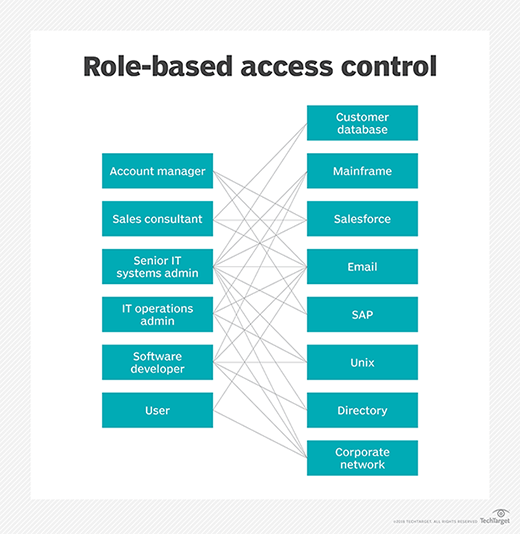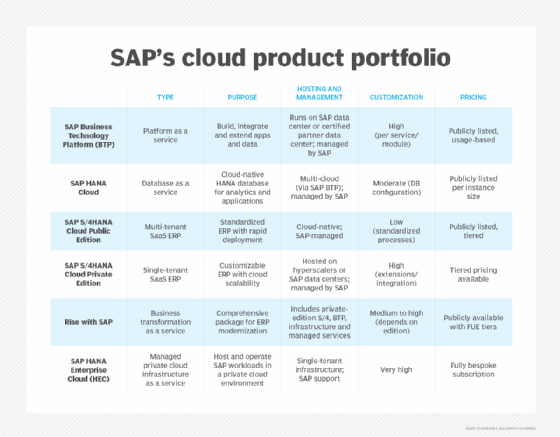What is SAP HEC (HANA Enterprise Cloud)?
SAP HEC (HANA Enterprise Cloud) is a managed, private infrastructure as a service (IaaS) offering that enables organizations to deploy and run SAP software applications on IT infrastructure managed by SAP. SAP HEC is a fully managed IaaS service, which means that SAP is responsible for providing, maintaining and supporting the underlying infrastructure. This leaves organizations free to focus on developing, deploying and running SAP applications in a secure environment without having to manage the IT environment themselves.
SAP HEC was launched in 2013 to provide enterprise users with a fully managed private environment for running SAP HANA and other SAP applications in the cloud. Originally, SAP hosted HEC offerings in its own data centers. Today, SAP partners with major hyperscale cloud providers, and HEC can also be hosted on Amazon Web Services (AWS), Microsoft Azure or Google Cloud Platform (GCP).
Key elements of SAP HEC
SAP HEC is a subscription-based, scalable offering that enables organizations to run SAP HANA and other SAP applications in a managed private cloud environment. It includes a best-practice reference architecture for deploying the SAP HANA in-memory database in the cloud and can support SAP S/4HANA ERP and SAP BW/4HANA workloads. SAP HEC also includes tools that support application deployment, as well as managed governance and security services aligned with customer requirements and compliance standards.
When a customer purchases a subscription for HEC, the first thing SAP does is conduct a detailed technology assessment of the customer's infrastructure, SAP applications and application extensions. Based on the results of the assessment, SAP tailors and provisions a customized private cloud designed to meet the customer's needs.
SAP HEC vs. SAP HANA
SAP HANA and SAP HANA Enterprise Cloud are often confused because they have similar names. To add to the confusion, they are often mentioned together because HEC was originally created to host HANA in a private cloud environment.
SAP HANA is an in-memory, column-oriented relational database management system developed by SAP. It's designed to support high-performance analytics and transactional processing on the same platform. Today, most new SAP applications use SAP HANA as the underlying database and compute engine, no matter where they are hosted.
Important features of SAP HANA include the following:
- In-memory storage. For in-memory storage, HANA stores data in main memory instead of on traditional disks or solid-state drives. RAM can be accessed tens of thousands of times faster than disk-based storage, which makes SAP HANA a good choice for applications that require high-speed data processing.
- Hybrid transaction/analytical processing. HANA HTAP can execute online transactional processing, or OLTP, and online analytical processing, or OLAP, workloads simultaneously on the same data set. Because SAP HANA supports hybrid data landscapes, it can work with a wide range of data types, including structured, unstructured, spatial, graph, text and time-series data.
- Real-time data replication. HANA uses real-time data replication to move data from source systems into the HANA database with minimal latency. This enables businesses to analyze current data without waiting for batch updates.
- Scalability. SAP HANA supports both scale-up architecture, or adding more resources to a single system, and scale-out architecture, or adding more nodes to a distributed system. This enables HANA to efficiently handle growing data volumes, increased workloads and high user concurrency.
- Security. SAP HANA's security framework is designed to protect data at rest and data in transit. Its role-based access controls ensure that only authorized users can access sensitive data or perform administrative tasks.

SAP HEC features
SAP HEC was also intended to support SAP's vision of the Intelligent Enterprise. The Intelligent Enterprise is not an SAP product. Instead, it's a framework that SAP designed to help organizations stay competitive by using AI and machine learning to automate routine tasks and workflows, streamline processes, drive innovation, and improve decision-making with real-time analytics.
Important SAP HEC features that support the SAP Intelligent Enterprise concept include the following:
- Built-in database orchestration and monitoring. SAP HEC enables compute, storage and network resources to be managed centrally by SAP staff. It also provides tools for monitoring system health and performance, as well as resources to help maintain uptime and consistent performance.
- Robust security. SAP HEC provides infrastructure and access layer support for native encryption, multifactor authentication and single sign-on to further strengthen security and safeguard data from losses and compromise.
- Managed services and operations. Unlike Azure, AWS and GCP, SAP HEC is not self-service. As part of its managed service, SAP is responsible for provisioning private clouds, configuring the environment in which SAP applications will run, patching, backups, restores and ongoing system monitoring.
- High availability and disaster recovery. SAP HEC extends SAP HANA's HA/DR capabilities by providing the infrastructure, automation and governance needed to enforce them. For example, HEC provides multisite redundancy, automated failover, disaster recovery testing, and support for backup and retention policies.
- Hybrid and multi-cloud deployment flexibility. HEC can be deployed in SAP-owned data centers and in certified hyperscale data centers that partner with SAP.
- Compliance and governance. The data centers that host HEC private clouds are held to stringent industry and regulatory certification standards. This lets customers focus on their SAP application layer without needing to independently certify the hosting environment.
Benefits of SAP HEC
SAP HEC is designed to support a lift-and-shift approach to migrating existing SAP applications to a managed private cloud. Because HEC preserves the underlying application architecture and runtime environment, companies can usually migrate to the cloud without major code refactoring. SAP's support can also help companies avoid the typical pitfalls and risks associated with complex migrations and replatforming. SAP is responsible for minimizing data loss, extended downtime, misconfigurations and system incompatibility issues.
Perhaps the main attraction of SAP HEC for most companies, however, is that it simplifies the deployment and operation of SAP HANA-based applications. Because SAP manages the private cloud environment, businesses don't have to use their own IT staff to manage the infrastructure that supports HANA-based SAP applications. This can be cost-effective in the long run, especially for companies that lack in-house expertise.
How to purchase SAP HEC
HEC is offered as a customized, subscription-based service whose price is negotiated. The procurement process begins by contacting SAP's sales team or submitting an inquiry through SAP's website. Once contact is established, SAP assigns a team of specialists to guide the customer through the rest of the procurement process.
First, SAP evaluates the customer's existing SAP landscape to determine workload needs, as well as compliance, scalability and performance requirements. Based on the assessment, SAP will then create a tailored infrastructure proposal that includes capacity planning and performance targets.
After the proposal is approved, negotiations are completed and the contract is signed, SAP provisions the HEC environment, configures it and -- if applicable -- migrates existing SAP applications to the managed private cloud. Once the environment is live, SAP provides ongoing management and support in accordance with the service-level agreement. Typically, customers purchase HEC as a new subscription, but they also have the option of revising their existing SAP licenses for the cloud, depending on their current licensing agreements and negotiations with SAP.
SAP HEC vs. Rise with SAP
Today, SAP HEC is often considered to be a legacy cloud offering. While it is still supported and used by organizations that have strict compliance requirements, over the last few years SAP has been steering customers toward Rise with SAP. Rise is a bundled business transformation-as-a-service offering that can support both SAP S/4HANA Cloud Private Edition and SAP S/4HANA Cloud Public Edition.
In addition to core enterprise resource planning (ERP) capabilities, Rise includes tools and services designed to help organizations adopt, integrate and benefit from AI across their operations. For example, Rise includes access to AI-powered features embedded in both SAP S/4HANA Cloud editions as well as AI development tools in the SAP Business Technology Platform. The bundle also includes tools for intelligent process optimization provided by SAP's business process intelligence services.
Unlike SAP HEC, which is priced on a custom basis, Rise with SAP offers tiered pricing based on Full User Equivalents and infrastructure requirements. This change is intended to help customers align cloud costs with business objectives more accurately and streamline vendor management through a single contract.

Understanding the differences between on-premises ERP and cloud ERP, particularly multi-tenant SaaS, is essential for making purchasing decisions. Explore a comparison of cloud vs. on-premises ERP in a dozen key areas.






